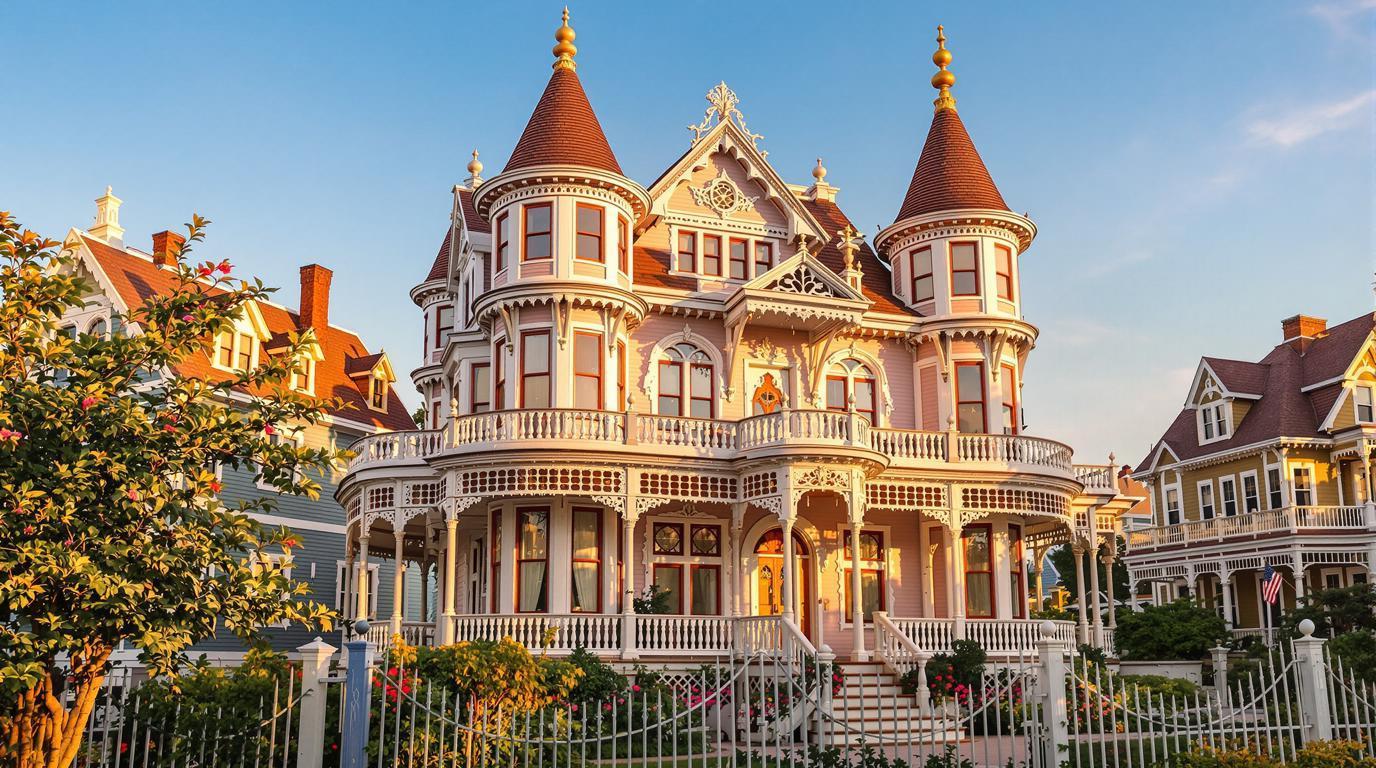The ferry horn echoed across Delaware Bay as I stepped onto Cape May’s weathered dock, instantly transported to an era when Victorian elegance defined American coastal luxury. While Ocean City’s boardwalk teems with summer crowds just 47 miles north, this 3,500-resident sanctuary at New Jersey’s southernmost tip guards America’s most authentic collection of preserved 1800s architecture. The Cape May-Lewes Ferry delivers you directly into a living museum where over 600 Victorian structures display their original gingerbread trim, creating an intimate coastal experience that mass tourism destinations simply cannot replicate.
Unlike the commercialized beach towns that dominate the Mid-Atlantic coast, Cape May earned National Historic Landmark status in 1976 for maintaining architectural integrity that transports visitors to the golden age of American seaside resorts. The Historic Preservation Commission enforces strict design standards, ensuring every restoration honors the town’s late 19th-century character while preventing the generic development that has consumed neighboring destinations.
Standing at the confluence where Delaware Bay meets the Atlantic Ocean, Cape May occupies a geographic position that naturally limits crowds while offering ferry access that bypasses summer traffic congestion entirely. This strategic location creates an exclusive coastal retreat where authentic Victorian charm takes precedence over mass market appeal.
The Victorian sanctuary that defies modern beach town commercialization
How did Cape May preserve what other coastal towns lost?
The answer lies in Cape May’s commitment to architectural authenticity over tourist volume. While destinations like Rehoboth Beach expanded with modern developments, Cape May’s preservation society maintained strict oversight of every building modification. The Emlen Physick Estate and Southern Mansion stand as testaments to this dedication, offering guided tours that reveal the social customs and architectural innovations of America’s Gilded Age elite who once summered here.
What makes Cape May’s gingerbread trim architecture irreplaceable?
Cape May’s Victorian structures feature intricate wooden details, ornate turrets, and hand-carved gingerbread trim that required master craftsmen to create. These authentic elements cannot be mass-produced, making each building a unique work of art. The concentration of such structures within walking distance creates an immersive experience that feels more like exploring a carefully curated outdoor museum than navigating a typical beach town.
Hidden ferry access that locals use to avoid summer crowds
Why does the Cape May-Lewes Ferry change everything?
The 17-mile ferry crossing from Lewes, Delaware, transforms your arrival into part of the authentic experience while completely avoiding the traffic-clogged highways that plague other shore destinations. January 2024 saw 262,411 non-commercial ferry crossings, with summer months showing even higher demand from travelers seeking this scenic alternative to congested roadways.
How does ferry access create a car-free Victorian experience?
Cape May’s compact 2.9-square-mile historic district allows visitors to explore the entire collection of Victorian architecture on foot after arriving by ferry. The walkable streetscapes, originally designed for horse-drawn carriages, create intimate encounters with gingerbread-trimmed houses that would be impossible to appreciate from a car window rushing through crowded beach traffic.
The exclusive coastal confluence tourists never discover
What happens where Delaware Bay meets the Atlantic Ocean?
Cape May’s position at this geographic confluence creates unique tidal patterns and coastal ecosystems that enhance the Victorian town’s natural beauty. The protected waters of Delaware Bay offer calmer conditions for ferry crossings while the Atlantic side provides traditional beach experiences, giving visitors access to two distinct coastal environments within the same destination.
Travel Note: “I discovered Cape May’s secret during a late afternoon ferry crossing when the Victorian silhouette emerged from the bay mist like a watercolor painting. The gingerbread trim caught the golden light in a way that made every house look like a carefully crafted dollhouse come to life.”
Insider access to authentic Victorian secrets
When do preservation society tours reveal Cape May’s hidden stories?
Summer walking tours led by local historians provide exclusive access to private Victorian interiors and architectural details invisible to casual visitors. These guided experiences reveal the social customs, building techniques, and family histories that shaped Cape May’s development during the 1850-1910 era when America’s wealthy elite established this as their preferred coastal retreat.
How do design standards protect Cape May’s authentic character?
The Historic Preservation Commission requires contemporary interpretations of Victorian styles rather than generic replications, ensuring new construction enhances rather than diminishes the town’s authentic character. This approach maintains Cape May’s living history while preventing the theme park atmosphere that compromises other historic destinations.
Frequently Asked Questions About Cape May’s Victorian Authenticity
Is Cape May really less crowded than Ocean City?
Yes, Cape May’s focus on architectural preservation over beach entertainment naturally attracts fewer crowds than Ocean City’s boardwalk attractions. The ferry access also disperses visitors throughout the day rather than creating the traffic-jam arrivals common at drive-to destinations.
Can you explore Cape May without a car?
Absolutely. The ferry delivers you directly into the walkable historic district where Victorian architecture tours, beaches, and restaurants are all within easy walking distance. Many visitors find the car-free experience enhances their connection to the town’s 19th-century atmosphere.
What’s the best time to visit Cape May for Victorian architecture?
Late spring through early fall offers the best combination of pleasant weather and full access to guided tours. July provides peak operating schedules for both ferry service and architectural tours, though booking advance reservations ensures access to the most exclusive experiences.
How does Cape May compare to other Victorian coastal towns?
Cape May’s National Historic Landmark status and concentration of over 600 preserved Victorian structures make it unique among American coastal destinations. While towns like Lewes have historic charm, none match Cape May’s comprehensive Victorian district maintained at such authentic levels.
The ferry’s evening departure whistle signals your last chance to experience authentic Victorian coastal elegance before summer crowds discover this Delaware Bay sanctuary. Cape May’s commitment to architectural preservation over mass tourism creates an increasingly rare travel experience where authentic history takes precedence over commercial development. Don’t wait for this 3,500-resident treasure to become another overcrowded shore destination.
